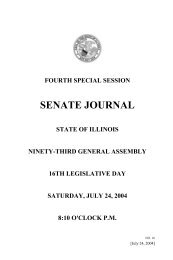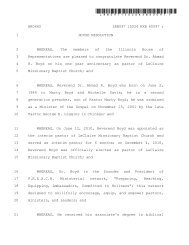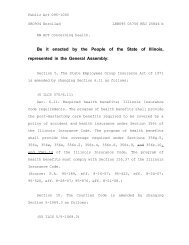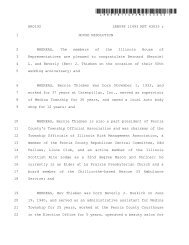Long-Term Care - Illinois General Assembly
Long-Term Care - Illinois General Assembly
Long-Term Care - Illinois General Assembly
Create successful ePaper yourself
Turn your PDF publications into a flip-book with our unique Google optimized e-Paper software.
eligibility determinations. Most of the case management is being done by area agencies on<br />
aging. Over half of the people use independent providers for services. They have a strong role<br />
for independent providers — i.e., individual providers as opposed to agency providers. Like<br />
most states, they are struggling with limited resources. They have had to limit the number of<br />
hours that all individuals receive services. They've now developed a system of allocating more<br />
resources to individuals with higher levels of disability, and less to others.<br />
Vermont has a strategic planning process. There's a website with information about that<br />
initiative. They have done several things. They've looked ten years ahead to try to determine<br />
disability patterns. They used a simulation-model put together by the Lewin Group. They've<br />
done a lot of work. They set a case mix goal for of home and community-based services and<br />
nursing home beds. They want 40 home and community-based services slots for every 60<br />
nursing home beds. They have hard numbers on the need for services that guides planning,<br />
and specific targets for services that they want to have in place. Looking at some of the data,<br />
looking at where it's going to take you in the future, is a key element of what they have done.<br />
Wisconsin is known for their current system and also their strategic planning process. They are<br />
the state that has probably moved the farthest with what we call managed long-term care. They<br />
have something called family care in several counties. They are providing a monthly payment<br />
that includes funding for nursing homes, community services, and administrative costs. It's all<br />
bundled into a single payment based on the average cost, as it is done in managed care and<br />
acute hospital settings. This is not something that you do overnight, but they are pleased with<br />
the results of integrating the payments, and then integrating the county resource centers, which<br />
are single-point-of-entry for everybody, offering advice and information. Individuals that qualify<br />
for services are overseen by county care management organizations. That system moves from<br />
information to care management and oversight. They have a website about that reform. They<br />
wouldn't tell you that they have this problem solved. There isn't any state that would tell you<br />
that, but I think trying to revamp their system to deal with some of the issues that continue to<br />
exist, including the fact that the family care system doesn't exist in every place in the state.<br />
They want to try to see if they can come closer to making it happen, including workforce issues<br />
and similar matters.<br />
In Texas they passed a law that allows people who are in nursing homes who want to move into<br />
the community to jump the waiver line. It's a special allocation of dollars in the waiver program<br />
for people who want to leave institutions. The money essentially moves in the budgeting<br />
system from the nursing home line to the community services line for those people that leave<br />
the institution. It was modified somewhat this year. It's something in which Texas is very<br />
pleased. Some states are not thrilled with that idea, because it gives preference to people who<br />
are in institutions for services, but it is something that is getting a lot of attention.<br />
James Varpness<br />
Director, Aging & Adult Services Division, Minnesota Department of Human Services<br />
(See Attachment C for power point presentation that guided this testimony)<br />
<strong>Long</strong>-term care reform in Minnesota birthed out of the “2030” project in 1997 and 1998, in which<br />
town hall and main-street meetings all across the state were talking about the demographic<br />
shifts that were going to be occurring. This was called “2030,” because that was the date in<br />
Minnesota where the 85+ population more than doubles. That got people very nervous. It got<br />
to be very scary, specifically about state finances. The state legislature was looking at how<br />
20
















